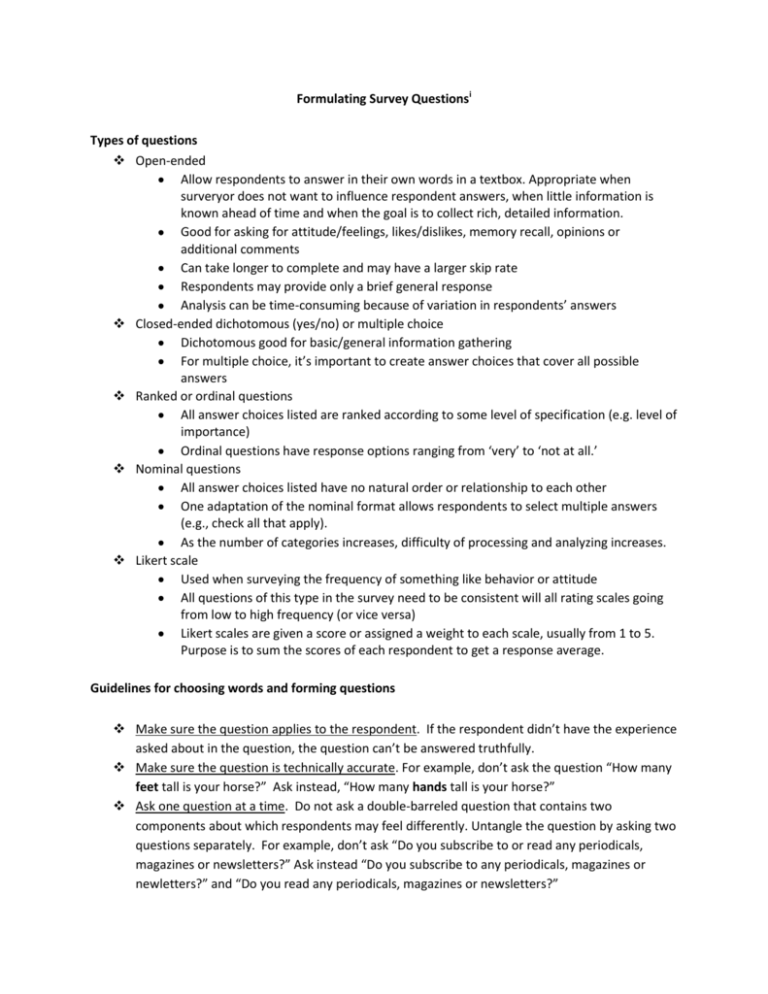Formulating Survey Questionsi Types of questions Open
advertisement

Formulating Survey Questionsi Types of questions Open-ended Allow respondents to answer in their own words in a textbox. Appropriate when surveryor does not want to influence respondent answers, when little information is known ahead of time and when the goal is to collect rich, detailed information. Good for asking for attitude/feelings, likes/dislikes, memory recall, opinions or additional comments Can take longer to complete and may have a larger skip rate Respondents may provide only a brief general response Analysis can be time-consuming because of variation in respondents’ answers Closed-ended dichotomous (yes/no) or multiple choice Dichotomous good for basic/general information gathering For multiple choice, it’s important to create answer choices that cover all possible answers Ranked or ordinal questions All answer choices listed are ranked according to some level of specification (e.g. level of importance) Ordinal questions have response options ranging from ‘very’ to ‘not at all.’ Nominal questions All answer choices listed have no natural order or relationship to each other One adaptation of the nominal format allows respondents to select multiple answers (e.g., check all that apply). As the number of categories increases, difficulty of processing and analyzing increases. Likert scale Used when surveying the frequency of something like behavior or attitude All questions of this type in the survey need to be consistent will all rating scales going from low to high frequency (or vice versa) Likert scales are given a score or assigned a weight to each scale, usually from 1 to 5. Purpose is to sum the scores of each respondent to get a response average. Guidelines for choosing words and forming questions Make sure the question applies to the respondent. If the respondent didn’t have the experience asked about in the question, the question can’t be answered truthfully. Make sure the question is technically accurate. For example, don’t ask the question “How many feet tall is your horse?” Ask instead, “How many hands tall is your horse?” Ask one question at a time. Do not ask a double-barreled question that contains two components about which respondents may feel differently. Untangle the question by asking two questions separately. For example, don’t ask “Do you subscribe to or read any periodicals, magazines or newsletters?” Ask instead “Do you subscribe to any periodicals, magazines or newletters?” and “Do you read any periodicals, magazines or newsletters?” Use simple and familiar words that are generally understood. Don’t use abbreviations or specialized phrases that are not commonplace for the respondent. The tendency of surveyors is to overestimate the knowledge and vocabulary of respondents. A food rule of thumb is that when a word is longer than 6 or 7 letters, a shorter and simpler word can probably be used in instead. Use specific and concrete words to specify concepts clearly. For example, don’t ask the question “How many times did you eat together as a family last week?” Ask instead “ How many meals did you eat together as a family at home last week?” Use as few words as possible to pose the question. The more information a respondent has to take in, the greater likelihood of misunderstanding the question. Use complete sentences with simple sentence structures. Don’t provide an incomplete sentence such as “Your city or town.” Ask instead “In what city or town do you live?” Make sure “yes” means yes and “no” means no. Don’t ask a double-negative question. For example, voters are often asked to vote for measures where a yes vote would result in something not being done. Be sure the question specifies the response task. Asking for a number of days in the question and then providing response options such as “always”, “most of the time”, “never” is not appropriate. i Material adapted from the publications: Survey Monkey User Manual: Customer Guide for Account Navigation, Survey Creation, Distribution & Analysis accessible on the website under Answers & FAQs, www.surveymonkey.com. D Dillman, J Smyth, LM Christian. Internet, Mail, and Mixed-Mode Surveys: The Tailored Design Method. (2009) John Wiley & Sons, Inc.











